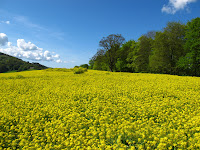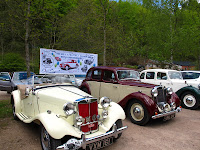The annual MG Y Type
Spring Run was based in Goodrich this year, on the border with Wales.
This seemed a perfect opportunity for one last visit to Wales.
Straight off the M4
motorway is Caerleon. This small town is built among the remnants of
a Roman border town. They have done a wonderful job of bringing the
Roman baths back to live, with use of clever lighting, and projected
swimmers using the pool.
Nearby are the remains
of the Roman barracks, and an easily identified Amphitheatre.
From here, our tour
took us to Abergavenny, and we had difficulty finding a park, we
wondered at all the visitors. It turned out to be market day and all
the neighbouring towns must have been visiting.
The town is well worth
a visit too, We started with the ruins of the castle, which has a
gruesome history. The founder visited in 1176, and invited all the
leading locals to a Christmas banquet.. While they were enjoying his
hospitality, William de Breos ordered his soldiers to kill them all.
He obviously didn't have a grasp of the true meaning of Christmas!
St Mary's Church is the
same age as the castle, but still complete and standing. Inside are
some handsome marble tombs, but the most interesting item is the
largest wooden sculpture in the UK. The reclining figure of Jessie is
carved on a section of a hollow tree, and is part of what was once
just the base of an even larger sculpture of the tree of Jessie.
The large indoor market
was very appealing, so not surprising so many people were visiting.
Not far from here, but
in a very remote spot, is White Castle. This was one of three English
castles controlling the Welsh border. We really enjoyed the calm and
peaceful spot, very different from the days when it was in use!
We were hoping for a
cup of tea, but surprisingly, this remote attraction does not have a
tea-rooms. We asked advice at the ticket office, and were
recommended 'to visit the Chinaman' near the second castle of the
fortified trio.
We found his tearooms,
and would have loved to have stayed the night (it's also a B&B).
The lovely old stone house overlooks gardens and an appealing valley
view. The tea and apple scone were just perfect.
Grosmont castle is
nearby, and this one has free entry, as it is slightly more ruined
than White Castle. Once again, a really dramatic statement on the
hillside above the town.
The last town we
visited was Llanvihangel Crucorney. This boasts the oldest pub in
Wales, so we had to call in for a drink. It was once a courthouse,
and we checked out the holding cell, and the beam where criminals
were hung. Certainly the most atmospheric place we've stopped in for
a drink.
Across the main road is
Llanvihangel Court. This had a sign outside advertising tours. We
thought it was another courthouse, and it may have been once, but now
it is a Tudor home, and so liveable and homelike, we were captivated.
It is probably is the most appealing historic house we have visited.
Full of wonderful period furniture, but totally delightful and felt
like a home.
We were the only two on
the tour, so we had a personal guided tour by the owner, who
mentioned a ruined abbey up a nearby valley. We decided we had just
enough time for one last visit, before the evening MG dinner.
The road up the valley
was very narrow, and we were delayed by a constant stream of traffic
coming the other way. When we finally reached the ruined Abbey, it
turned out that the crowds had been at the Black Mountain challenge.
Fortunately, by the time we made it there, the crowds had nearly
left, and we were able to experience the abbey atmosphere.

















































